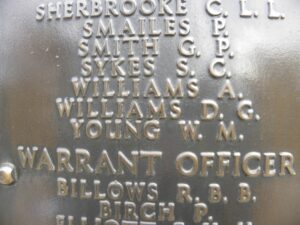Newcastle Emlyn is an ancient market town, lying on the River Teifi, and straddling the borders of Carmarthenshire and Ceredigion. The town is home to a ruined 13th Century Castle, which is situated to the north of the Teifi. The men of the town who fell during both World Wars are commemorated on a granite column which sits in the Memorial Gardens. Several men were discovered during the research to have had links with Newcastle Emlyn, but are not remembered on the War Memorial, so these men are also remembered below.

The Great War, 1914-1918
Francis Harry Vaughan Bevan, Captain, Royal Flying Corps. Francis was born in Blaina in 1895, the son of Henry Crook Bevan and Fanny Eleanor Bevan. His parents later moved to Maeseithin, Newcastle Emlyn. Francis had been commissioned into the 8th Battalion, South Wales Borderers, and had served at Gallipoli and in Mesopotamia before volunteering to serve with the Royal Flying Corps. He was posted to Egypt, where he joined 14 Squadron, Royal Flying Corps. The Squadron supported the army during the Palestinian campaign. He was killed on 19 April 1917, during the Second Battle of Gaza, while flying as part of a special detachment, in support of the forces of Lawrence of Arabia. Francis was 22 years old, and is commemorated on the Jerusalem Memorial, Israel. There is also a plaque in Beersheba War Cemetery, which bears the name of eight airmen, who were shot down over Palestine, and whose graves were never found. The plaque was erected by Turkish soldiers, originally as a face to an obelisk, in respect of their enemy. Francis is not commemorated locally.

William Morris Christmas, Private, 4/7710, Northumberland Fusiliers. William was the son of Mary Christmas, of Water Street, Newcastle Emlyn. He married Elizabeth Wills at Merthyr Tydfil in 1914, but Elizabeth sadly died in the winter of 1915, aged just 26. William enlisted at Cardiff into the army, and was posted to the 1/4th Battalion, Northumberland Fusiliers. The Battalion had been formed during August 1914, and remained on the Tyne Defences until April 1915 before moving to France. On 14 May 1915 the formation became 149 Brigade, 50th Division, and moved to Ypres, where they took part in the Second Battle of Ypres from April to June 1915. During the summer of 1916 the Division were on the Somme, where they fought at the Battle of Flers-Courcelette, the Battle of Morval and the Battle of Le Transloy. After spending a winter on the Somme, they moved north to Arras, where they took part in the Arras Offensive of April 1917, and fought at the First Battle of the Scarpe, capturing the Wancourt Ridge. They then fought at the Second Battle of the Scarpe, and remained in the area throughout the Offensive, which is where William was killed in action, on 29 June 1917. He was 24 years old, and is buried at Wancourt British Cemetery, France.
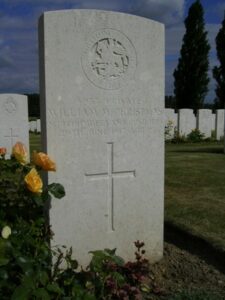
David Rees Davies, Private, 3rd Chemical Warfare Section, U.S. Army. David was born on 24 December 1892, the son of Benjamin and Anne Davies, of Bryndioddef, Newcastle Emlyn. He had served with the Royal Garrison Artillery prior to the war, before emigrating to America aboard the S.S. Lusitania on 21 March 1914. David enlisted in the USA into the 3rd Battalion, Chemical Warfare Service, American Expeditionary Force. He died in the USA on 11 October 1918, aged 25, and is buried at Jerusalem Cemetery, Wales, Waukesha, Wisconsin. The Memorial at Newcastle Emlyn states that David served with the 164th Depot Battalion, Royal Garrison Artillery, but his headstone states 3rd Battalion, Chemical Warfare Service. He is not commemorated by the CWGC or the ABMC. Many thanks to Raymond Jones for identifying David.

Tom Davies, Private, 201674, Welsh Regiment. Tom was the son of William and Sarah Davies, of Pwllglas, Llandyfriog. He served during the war with the 1st/6th Battalion, Welsh Regiment, which was the Pioneer Battalion to the 1st Division. The Division had been one of the first to arrive in France, fighting at the retreat from Mons to the Marne. They then fought at the Aisne, and at Chivy, before being moved north, and fought at the First Battle of Ypres. The following year saw them in action at the Battle of Aubers, and the Battle of Loos. During 1916 they fought during the Battle of the Somme. They followed the German retreat to the Hindenburg Line in early 1917, and later that year during the Second Battle of Passchendaele. After spending another Winter in Flanders, they were near Estaires when the German Spring Offensive caught them, before being moved South to Arras, fighting at the Battle of Drocourt-Queant, and at the Battle of Épehy. The Division pushed on towards the St. Quentin Canal, and after crossing the Hindenburg Line fought at the Battles of Beaurevoir, the Selle and the Sambre. Tom survived the war, but became ill and died on 2 December 1918, aged 27. He is buried at Premont British Cemetery, France. Tom is also commemorated at Bryngwenith Chapel, Henllan.
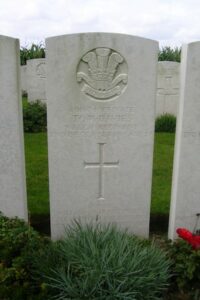
William Lloyd Davies, Wheeler, T4/060246, Royal Army Service Corps. William was born in 1888, the son of John and Rachel Davies, of 2, Mill Street, Newcastle Emlyn. He served with the 12th Divisional Ammunition Column, Army Service Corps during the war, after landing with his unit at Boulogne on 30 May 1915. The Division saw much action during the course of the war, fighting at Loos in September 1915, then on the Somme the following year. During 1917 it took part n the Batle of Arras and the Battle of Cambrai, and during the final year of the war saw heavy fighting on the Somme during the German offensive of March 1918, before participating in the great offensive, which ultimately won the war. William survived all of this, but was gassed during the latter stages of the war. On 17 April 1919 he was demobilised, and returned to Newcastle Emlyn, where he died on 23 February 1920, aged 32, as a result of his gassing. William is not commemorated by the CWGC.

David Jones Edwards, Private, 301433, Tank Corps. David was born at Llwyngwril in 1897, the son of Police Sergeant Thomas William Edwards and Jane Ann Edwards (nee Sutton). The family had lived at Aberdovey and Corwen, but when Thomas retired from the Police, the family moved to 5, Glyndwr, Glyndyfrdwy. David was educated at Corwen Council School and Bala County School, then worked as a Clerk at the National and Provincial Bank at Newcastle Emlyn prior to the war. He enlisted at Carmarthen into the 2/5th Battalion, East Kent Regiment (The Buffs). David was then transferred to the 3/4th Battalion, Queen’s (Royal West Surrey’s), before being transferred to the Tank Corps, and was posted to the 13th Battalion, Tank Corps. The Tank Corps had suffered heavy losses during the Battle of Cambrai in November and December 1917. David probably joined the 13th Battalion among a draft of reinforcements after the battle. During the Spring of 1918 the 13th Battalion, Tank Corps was at Boescheppe, in Flanders, attached to the 4th Tank Brigade, which had its HQ at Godewaersvelde. On April 9 the Germans launched the second phase of their great attack against a line running from Festubert and Fleurbaix against the British front, and broke through the thinly stretched defenders. David’s battalion, now converted to a Lewis-Gun unit, had orders to hold a line west of Merville. On 25 April 1918 the Germans hit the positions held by the 13th Battalion, causing terrible casualties among the defenders. David was killed in action during the fighting that day. The 20-year-old has no known grave and is commemorated on the Tyne Cot Memorial, Belgium. David is not commemorated locally.

David Emlyn Esau, Driver, 137098, Royal Field Artillery. David was the son of William John and Catherine Esau, of Pantybwlch, Newcastle Emlyn. He enlisted at Preston into the Royal Field Artillery, and was posted to the 79th Small Arms Ammunition Column, which was attached to the 79th Brigade, 26th Division. Embarkation for France began in September 1915, and the concentration of units at Guignemicourt, west of Amiens, was completed before the end of the month. However in November 1915 the Division moved to Salonika, where it then remained. On 26 December 1915 units began to move from Lembet to Happy Valley Camp, and all units were in place there by the 8th February. The Division then took part in the Battle of Horseshoe Hill, between the 10th and the 18th August 1916, the Battle of Doiran between 24 April and 9 May 1917. David sadly died of dysentery on 5 October 1917. He was just 22 years old, and is buried at Mikra British Cemetery, Kalamaria. David is also commemorated at Drefach Velindre.

David Richard Evans, Gunner, 51623, Royal Garrison Artillery. David was born in Newcastle Emlyn, and enlisted at Bargoed into the Royal Garrison Artillery. He was posted to the 101st Siege Battery, which comprised four 6″ howitzers (26 cwt 1915 model). They were part of the 19th Heavy Artillery Group, which did their final training at Fareham, and were ordered to France on 9 May 1916. An advanced element left on the 18th and the rest of the battery on the afternoon of the 20th. They left from Southampton in the SS Caeserea, disembarking at Rouen at midnight. Their guns, lorries and stores arrived on the 23rd. The Battery took part in the 46th Division’s attack of Gommecourt during the opening of the Somme Offensive, and fought on the Western Front for the remainder of the war. David was wounded towards the end of 1917, possibly at Passchendaele or Cambrai, and returned home for treatment. He died of wounds on 19 January 1918 and is buried at Brookwood Military Cemetery, Surrey. David is not commemorated locally.

Edward David Evans, Acting Company Sergeant Major, 14401, Kings Shropshire Light Infantry. Ted was born in 1887, the son of Edward and Elizabeth Evans, of 15, Baker Street, Aberystwyth. Prior to the outbreak of war he had worked at the L C & M Bank in Newcastle Emlyn. He enlisted at Carmarthen into the 7th Battalion, Kings Shropshire Light Infantry in September 1914 along with his close friend David Rees Davies. On 28 September 1915 the Battalion landed at Boulogne, joining 8 Brigade, 3rd Division at Meteren. The Division then moved to the Ploegsteert Wood sector, before moving to the Busseboom Sector at Ypres. The 7th KSLI took up positions in Sanctuary Wood, and fought at the Actions of the Bluff, and at the St Eloi Craters. The Division was then moved south to the Somme, and fought there at the Battle of Albert. During an assault on the German trenches at Bazentin Ridge on 14 July 1916, Ted’s company was caught on barbed wire and came under heavy fire from enemy machine guns. Ted was killed in action that day, and is commemorated on the Thiepval Memorial, France. He had severely felt the death of his old friend Sergeant David Rees Davies, of Aberystwyth, who had enlisted at the same time and had been killed a few weeks earlier. Edward is commemorated on several memorials in Aberystwyth and on the Bethel Chapel Memorial at NCE.

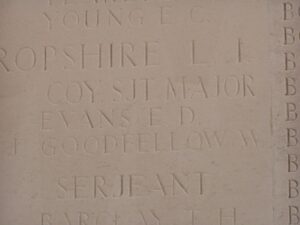
Edward Lloyd Evans, Private, 13059, Welsh Regiment. Edward was the son of Edward and Sarah Ann Evans, of Newcastle Emlyn, and enlisted at Carmarthen into the 9th Battalion, Welsh Regiment. The Battalion was attached to 58 Brigade, 19th (Western) Division, which crossed to France during July 1915, and fought during the opening attack of the Battle of Loos on 25 September. The Division suffered heavy casualties at Loos, and Edward was one of many men drafted into the 9th Welsh to rebuild its strength. During 1916 the division moved to the Somme, and took part in the second wave of the attack on Ovillers-La Boiselle on 1 July 1916 capturing the village at heavy cost. It remained on the Somme, and fought through the Somme Battles of Pozieres and the Ancre in 1916. During 1917 the division moved to positions south of Ypres, and this is where Edward was killed in action on 3 May 1917. He was just 22 years old, and is buried at Vlamertinghe Military Cemetery, Belgium. Edward is also commemorated at Bryngwenith Chapel, Henllan.

Evan Evans, Private, 72988, Royal Welsh Fusiliers. Evan was the son of William Evans, of Craigyrhaud, Newcastle Emlyn, and the Husband of Myfanwy Evans, of 1, Gordon Terrace, Swansea. He enlisted at Swansea into the 25th Battalion, Royal Welsh Fusiliers, which was formed in Palestine in 1917 by the merger of the Welsh Horse and the Denbighshire Yeomanry. They were attached to 231 Brigade, 74th (Yeomanry) Division, which had formed in Egypt in January 1917 and had fought through the Palestinian Campaign, at the Battles of Gaza and the Battle and capture of Jerusalem. Due to the terrible casualties suffered by the British on the Western Front in March and April 1918 the Division was recalled to the Western Front, and arrived at Marseilles during May 1918. They then fought at the Second Battle of Bapaume during the great offensive, and fought in Flanders before returning to the Somme and fighting at the Battle of Epehy, as part of the offensive towards the Hindenburg Line. Evan was wounded at Epehy, and died of wounds on 19 September 1918. He was 29 years old, and is buried at Doingt Communal Cemetery Extension, France.
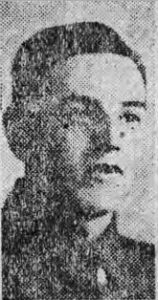

Haydn Stanley Evans, Private, 203096, Welsh Regiment. Haydn was the son of John and Hannah Evans, of 2, Cawdor Terrace, Cenarth. He had worked with his mother Hannah in their shop at Llanelli prior to 1911, before marrying, and living with his wife Margaret Evans, at 22, Wellfield Terrace, Llanelli. He enlisted there into the 1st Battalion, Welsh Regiment, which was attached to 84 Brigade, 28th Division. The Division formed in England between December 1914 and January 1915 from regular units returning from India, Singapore and Egypt. During January 1915 it moved to France, landing at Le Havre and moved to the Western Front, where it saw its first major action during the Second Battle of Ypres. Following serious casualties at Ypres, a Composite Brigade was formed, composing of the 2nd Battalion, the Buffs, 2nd Battalion, the Cheshire’s, 1st Battalion, the Welsh, and 1st Battalion, the York and Lancaster. It was dissolved on 19 May 1915, and the formation assumed its normal configuration, taking part in the Battle of Loos. During October 1915, the Division embarked at Marseilles, and proceeded to Egypt, and in November moved on to Salonika where the Division then remained. Haydn was accidentally killed in Salonika on 22 May 1918. He was 28 years old, and is buried at Sarigol Military Cemetery, Kriston. He is also remembered on the grave of his mother, at Box Cemetery, Llanelli.

James Evans, Driver, W/2795, Royal Field Artillery. James was the son of Joshua and Hannah Evans, of Glaspant, Cilrhedyn. He had worked as a miner at Llangeinor prior to the war, and in 1910 returned home to marry the widowed Elizabeth Waddup (nee Rees), of the Fox and Hounds, Cwmcych. The couple then lived at 7, Brynhyfryd, Pontycymmer. James enlisted at Bridgend into the Royal Field Artillery. He served with their ‘A’ Battery, 119th Brigade, which was attached to the 38th (Welsh) Division. The Division had landed in France during December 1915 and had spent their first winter in the trenches near Armentieres. In June they marched south to the Somme, where they were tasked with the capture of Mametz Wood. The attack on the wood began on 7 July, but met with fierce resistance, and it took four days to clear the wood. The Division suffered terrible casualties at Mametz, and were taken out of the line, and moved to Ypres to rebuild. Here they fought at Pilckem and Langemarck, then moved to Armentieres, where they remained from September 1917 until March, 1918 when the German Spring Offensive was launched. In April the Division were moved to the Somme, but James was killed in action prior to the move, on 17 April 1918. He was 46 years old, and is buried at Le Grand Hasard Military Cemetery, Morbecque. He is also commemorated at Newcastle Emlyn. Elizabeth returned to West Wales, to live at 7, Penlan Terrace, Newcastle Emlyn.

William Auryn Evans, Private, 39508, Welsh Regiment. William was born in Aberdare, the son of Hannah Evans. The family resided at Glazier Row, Newcastle Emlyn prior to the war, before William moved to Tyn y Bonau, Pontarddulais. He enlisted at Llanelli into the 2nd Battalion, Welsh Regiment, which was attached to 3 Brigade, 1st Division. William joined the Battalion in 1916, after it had taken part in the Battles of Aubers and Loos. Again they were required for a major offensive, moving south to the Somme, where they fought during the opening of the Somme Offensive at the Battle of Albert, then at Bazentin, Pozieres, Flers-Courcelette and Morval. They followed the German retreat to the Hindenburg Line in early 1917, and were then briefed for an operation on the Flanders Coast, and moved there during the summer of 1917. While training on the coast, the Battle of Third Ypres had stalled in the mire, and the Division were recalled to Ypres, where they fought at the Second Battle of Passchendaele where William was killed in action on 9 November 1917, aged 19. He has no known grave, and so is remembered on the Tyne Cot Memorial, Belgium. William is also commemorated at Pontardulais.

John Kenrick Lloyd Fitzwilliams, MC, Major, Royal Field Artillery. John was born on 13 December 1884, the son of Charles Home Lloyd Fitzwilliams and Margaret Alicia Fitzwilliams (nee Crawford), of Cilgwyn, Newcastle Emlyn. On 7 June 1910 he married Margery Laura Hyde, of Longworth House, Faringdon, Berks. John had been originally commissioned into the Royal Field Artillery, and by the start of the Battle of the Somme he had worked his way up to Captain. John was awarded the Military Cross for his conspicuous gallantry during the Somme Battles, and was also promoted to Major at the same time. His Battery served with the 25th Army Brigade, 1st Division and was taking part in the Advance on the Hindenburg Line when John was killed in action on 30 August 1918. He was 33 years old, and is buried at Vis-En-Artois British Cemetery, Haucourt. John was also the holder of the Order of St Stanislaus, 2nd Class (Russia). His son, Major Anthony John Fitzwilliams Hyde was killed in Normandy on 21 June 1944. John is also commemorated at Llandyfriog.

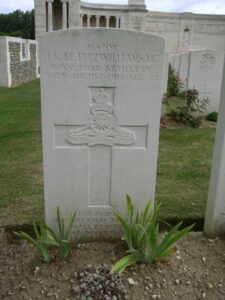
John Griffiths, Private, 15217, Welsh Regiment. John was the son of John and Mary Griffiths, of Rehoboth, Cwm-Coy, Newcastle Emlyn, and the Husband of Beatrice May Griffiths, of 17, Corbett St., Ogmore Vale, Glam. He enlisted at Cardiff into the Monmouth Regiment, but later transferred to the 1/6th Battalion, Welsh Regiment. The Battalion were Pioneers to the 1st Division, which had been one of the first to arrive in France, fighting at the Battle of Mons, and taking part in the retreat to the Marne, where the Germans were stopped. They then fought at the Aisne, and at Chivy, before being moved north to Ypres. Here they fought at the First Battle of Ypres, where they again stopped the German Offensive, before wintering in Flanders. The following year saw them in action again at the Battle of Aubers, before moving South to Loos, where they fought during the Battle of Loos, and the action at the Hohenzollern redoubt. Again they were required for a major offensive, moving south to the Somme, where they fought during the opening of the Somme Offensive at the Battle of Albert, then at Bazentin, Pozieres, Flers-Courcelette and Morval, which is where John was wounded. He died of wounds on 28 September 1916 aged 36, and is buried at Dernancourt Communal Cemetery Extension, France.

John George Griffiths, Driver, 80296, Royal Field Artillery. John was the son of Richard and Anne Griffiths, of Derwanlas, Llandyfriog, Newcastle Emlyn. He enlisted at Mountain Ash into the Royal Field Artillery, and served with their ‘A’ Battery, 76th Brigade, attached to the Guards Division. The Division has the distinction of being formed in France in August 1915. The various Guards units that had been with other Divisions were withdrawn to be brought together to create this fine formation. It remained on the Western Front throughout the war and saw its first major action during the Battle of Loos on 25 September 1915, remaining in the area during the coming months, where they also fought in the subsequent Action of Hohenzollern Redoubt. In July, 1916 the Division moved to the Somme, where they fought at the Battle of Flers-Courcelette, and then at the Battle of Morval, capturing Lesboeufs Village. They remained here for the winter, which is where John took ill. He died of bronchitis on 6 March 1917 aged just 19, and is buried at Grove Town Cemetery, Meaulte. John is also commemorated at Aberbanc and Llandyfriog.


Thomas James Harries, Rifleman, 616, London Regiment. Thomas was the son of Police Serjeant William Harries and of Jane Harries, of Dryslwyn, Newcastle Emlyn. Thomas had lived with his Aunt Elizabeth Wheeler at 11, Cavendish Road, Harringay prior to the war and worked as a Clerk in the Registry Office, G.P.O., London. He enlisted there in September 1914 into the 5th Battalion (Rifle Brigade), London Regiment. In November 1914 the Battalion moved to France, landing at Le Havre. Here they joined 11 Brigade, 4th Division at Bailleul, and spent their first winter in the trenches at Ploegsteert Wood, where they took part in the famous Christmas Truce. They remained here throughout the coming months, and were in the front line when Thomas was shot in the head by a sniper. He died immediately that day, on 15 April 1915, aged just 20, and is buried at Rifle House Cemetery, Belgium, deep within the Wood. He is also commemorated on the Bethel Chapel Memorial at NCE.


John Howells, Private, 8571, Dorsetshire Regiment. John was born in Newcastle Emlyn in about 1882. He resided with his cousin David Roderick at 245, Park Road, Cwmparc, Treorchy prior to the war, where he worked as a colliery carpenter, and he enlisted at Pentre into the Dorsetshire Regiment on 3 September 1914. John landed in France on 18 May 1915 and was posted to the 1st Battalion, Dorsetshire Regiment. The Battalion was attached to 95 Brigade, 32nd Division in December 1915, and the following year took part in the opening of the Somme Offensive, fighting at the Battle of Albert. John was killed in action during the initial attacks of the first day of the Battle of the Somme, on 1 July 1916, aged 36. He is buried at Lonsdale Cemetery, Authille, France.
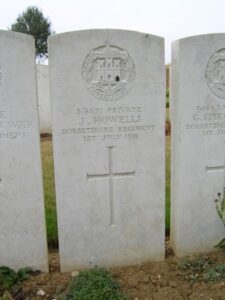
David James, Private, 54510, Welsh Regiment. David was the Husband of Mary James, of 2, Glaciers Row, Newcastle Emlyn. He served with the 19th Battalion, Welsh Regiment, which was the Pioneer Battalion to the 38th (Welsh) Division. The Division had landed in France during December 1915 and had spent their first winter in the trenches near Armentieres. In June they marched south to the Somme, where they were tasked with the capture of Mametz Wood. The attack on the wood began on 7 July, but met with fierce resistance, and it took until 12 July to clear the wood. The Division suffered terrible casualties at Mametz, and were taken out of the line, and moved to Ypres to rebuild, and remained here for the next twelve months, in the front north of Ypres. David was killed in action here on 28 July 1917, prior to the Divisions attack on the Pilckem Ridge. He was 29 years old, and is buried at Bard Cottage Cemetery. David is also commemorated at Cenarth.

Ieuan James Jenkins, Sapper, 397642, Royal Engineers. Ieuan was born in 1879, the son of David and Elizabeth Jenkins, Railway Temperance Hotel, Newcastle-Emlyn. Very little is known of his service, but prior to the war Ieuan had moved to Aberdare, where in 1904 he had married Edith Thomas, and the couple had six children. Ieuan returned home after the war a very sick man, and on 15 October 1920 he passed away from Spanish Flu. He is buried at Aberdare Church Cemetery, but he is not commemorated by the CWGC. Many thanks to his Great Nephew Clive Ball for supplying the information about Ieuan, and for the photo.

Harry Emlyn Jones, Driver, T2/025600, Royal Army Service Corps. Henry was the son of David and Lizzie Jones, of Graig Villa, Newcastle Emlyn. He served with the Horse Transport Section of the 12th Divisional Train, Army Service Corps, which served with the 12th (Eastern) Division. The Division had landed at Boulogne on 31 May 1915, and took over the line at Ploegsteert Wood. During the course of the war it fought at the Battle of Loos in 1915, and on the Somme in 1916. During 1917 it took part in the Battle of Arras, and at the Battle of Cambrai later that year. The Division relieved the 38th (Welsh) Division in the Fleurbaix sector in February 1918, and the following month moved to the Somme sector, where it became embroiled in the German offensive there, suffering heavy casualties. The division then rebuilt strength before taking part in the great offensive in August 1918, which ultimately won the war. Henry survived for most of the war, but died in France on the penultimate day of the war, on 10 November 1918, aged 25. He is buried at Brebieres British Cemetery, France. Harry is also commemorated at Llandyfriog, on the 12th Divisional Train Memorial.
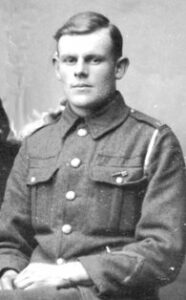

James Jones, Private, 41657, Yorkshire Regiment. James was the son of Thomas and Mary Jones, of Penranthebog, Cwmcoy, Newcastle Emlyn. He enlisted at Brecon into the Royal Field Artillery, but at some time in the winter of 1917 transferred into the 13th Battalion, Yorkshire Regiment, which was at Cambrai attached to 121 Brigade, 40th (Bantam) Division. The division had suffered terrible casualties during the Battle of Cambrai, playing an important role in the attack on Bourlon Wood. They remained in the area over the coming months, but were caught here by the German Spring Offensive of 21 March 1918, and fought there at the Battle of St Quentin and retreating back westwards fought at the First Battle of Bapaume. Due to the terrible casualties suffered by the Division here they were sent north to Flanders to rest and rebuild, but in April the Germans launched an offensive in Flanders, and the 40th Division was caught up in the thick of it again, fighting at the Battle of Estaires, which is where James was killed in action on 10 April 1918, aged 26. He has no known grave, and so is remembered on the Ploegsteert Memorial, Belgium. James is also commemorated at Bryngwyn Chapel.

James Arthur Jones, Private, 59656, Royal Welsh Fusiliers. James was the son of Ben and Achsah Jones, of Plas Hill Llandyfriog, Newcastle Emlyn. He enlisted at Marylebone into the Royal Welsh Fusiliers, and was posted to France, probably in the summer of 1916, joining the 13th Battalion, Royal Welsh Fusiliers, who were attached to 113 Brigade, 38th (Welsh) Division. The Division had moved to Ypres from the Somme, where it had suffered heavy casualties during the capture of Mametz Wood. Here they fought at Pilckem and Langemarck, then moved to Armentieres, where they remained from September 1917 until March 1918 when the German Spring Offensive was launched. The British had been over-run on the Somme, and so in April the Division was moved south, taking up positions North of Albert, from where they weathered the storm of the coming months, until the war turned during the Battle of Amiens, on 8 August 1918. The Germans had now lost the upper hand, and the British regained the lost ground on the Somme after an attack which began on 21 August, with the 38th Welsh in the midst of the attack during the Battle of Albert, and then moving east, where they fought at the Battle of Bapaume. Then the move began towards the mighty Hindenburg Line, and the Division carried on with their march east, fighting at the Battle of Havrincourt, and the Battle of Epehy. A short rest period ensued, during which time the Canal du Nord was breached, so opening a passage through the Hindenburg Line. The Division then fought at the Battle of Beaurevoir, and moved up towards Cambrai, where James was killed in action on 8 October 1918. He was 30 years old, and is buried at Moulin-De-Pierre British Cemetery, France. James is also commemorated at Aberbanc, Llandyfriog, and Bryngwenith Chapel, Henllan.
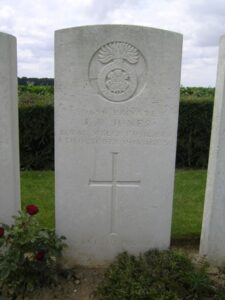
John Jones, Private, 11208, Hampshire Regiment. John was born in Penboyr in 1886, the son of David and Margaret Jones. The family had lived at Newcastle Emlyn for several years before moving to 42, Harriet Street, Trecynon, Aberdare. John enlisted at Cardiff into the 11th Battalion, Hampshire Regiment, which was attached to the 16th (Irish) Division as Pioneers, and during December 1915 the Division moved to France, concentrating in the Bethune area. John was wounded here, and died of wounds on 6 May 1916. He was 30 years old, and is buried at Bethune Town Cemetery, France. John is not commemorated at NCE.

Samuel Richard Jones, Private, 372382, Royal Army Medical Corps. Samuel was the son of Thomas and Judith Jones, of Aberarad, Newcastle Emlyn, and enlisted at Cardiff on 27 October 1915 into the Royal Army Medical Corps. Samuel was then posted to the 3rd Western General Hospital, Neath. He became ill there, and died of tuberculosis on 30 July 1917, aged 32. Samuel is buried at Llandyfriog (St. Tyfriog) Churchyard.

William Enson Jones, Lance Corporal, 20108, Welsh Regiment. William was born at Llandyfriog on 29 August 1888, and moved to Garnant prior to 1911 to work for the Great Western Railway. He married Hannah Jones (nee Rees), a widowed mother of four young children, in 1910, and the couple resided at Tyddewi, Garnant Road, Garnant. William enlisted at Ammanford into the 15th Battalion, Welsh Regiment, which was known as the Carmarthen Pals battalion. After training at Rhyl and Winchester the battalion moved to France on 2 December 1915 attached to 114 Brigade, 38th (Welsh) Division. William didn’t go out to France with the battalion, but was posted out with a number of reinforcements to the 16th Battalion, Welsh Regiment, which was attached to the same division. He was probably wounded during the battalions gallant attack on Mametz Wood on 7 July 1916, and returned home where he died on 21 July 1916, aged 29. He is buried at Garnant (Old Bethel) Welsh Congregational Chapelyard. William is also commemorated at Llandyfriog.

Titus Lewis, Private, 15661, Welsh Regiment. Titus was the son of Thomas and Mary Lewis, of Brynhyfryd, Adpar, Newcastle Emlyn. He enlisted at Neath into the 9th Battalion, Welsh Regiment, which was attached to 58 Brigade, 19th (Western) Division. The battalion moved to France on 18 July 1915, and moved with the division to positions near Loos, where it took part in the opening attack of the Battle of Loos on 25 September 1915. Titus was killed in action during this attack, on 25 September 1915. He was 25 years old, and is buried at Brown’s Road Military Cemetery, Festubert, France.


David Thomas Morgan, Private, 29247, Somerset Light Infantry. David was born in Newcastle Emlyn, the son of David and Margaret Morgan. The family later resided at 42, Herbert Street, Aberdare. David enlisted at Aberdare into the Army Service Corps and was serving in France as a Motor Transport Driver by early 1917. He later transferred into the 1st Battalion, Somerset Light Infantry, which was attached to 11 Brigade, 4th Division. The Division was one of the first Divisions to move to France, arriving just in time to join the hard-pressed Divisions of II Corps at The Battle of Le Cateau. They then took part in the epic retreat to the Marne, where the German Offensive was halted, and in the advance to the Aisne. The Division was then moved north to Flanders, and took part in the Battle of Messines, where Units of 4th Division took part in the famous Christmas Truce while they were still in this area, in trenches near Ploegsteert Wood. In 1915 the Division fought at the Second Battle of Ypres, and in the summer of 1916 were on the Somme, where they fought at the Battle of Albert and the Battle of Le Transloy. In April 1917 they were at Arras, and fought at the First Battle of the Scarpe, and the Third Battle of the Scarpe, before moving back to Ypres, taking part in the Battle of Polygon Wood, the Battle of Broodseinde, the Battle of Poelcapelle and the First Battle of Passchendaele. In spring 1918 the Division fought at the First Battle of Arras, and were then moved back to Flanders, where they took part in the Battle of Hazebrouck, where David was wounded. He died of wounds on 19 May 1918 aged 26, and is buried at Pernes British Cemetery, France. David is not commemorated locally.

Thomas George Otterwell, Private, 2137315, Canadian Infantry. Thomas was born in Radwinter, Essex on 23 November 1894, the son of James and Lydia Otterwell. Following the death of his father in 1894, his mother married John Freeman, and moved to Garregwen, Adpar, Newcastle Emlyn. Thomas was placed in a home following his mother’s re-marriage and was taken to a children’s home in Sherbrooke, Quebec in 1910. He had found work as a farmer prior to enlisting in British Columbia on 15 June 1917 into the 102nd Regiment, Canadian Infantry and was posted to England, before moving to France to join the 47th Battalion, Canadian Infantry on 21 September 1917. He joined the battalion in the trenches on the La Coulette front, near Ypres, where the Third Battle of Ypres was still raging. On 25 October the 47th Battalion moved forwards from Hill 37 to take over the line at Abraham Heights, in readiness for a renewed assault on the Passchendaele Ridge. Thomas appears to have been killed here at some time between 26 and 28 October 1917. He was 22 years old and is commemorated on the Ypres (Menin Gate) Memorial, Belgium. He is not commemorated at Newcastle Emlyn.
John Owen, Driver, T/1863, Army Service Corps. John was born at Cardigan, but resided at Newcastle Emlyn prior to the war. He enlisted at Pentre into the Army Service Corps, and was attached to the Welsh Division Train, part of the 53rd (Welsh) Division. The Division moved to the Mediterranean, sailing from Devonport in July, 1915 arriving at Mudros by 5 August 1915. From here they moved to Gallipoli, landing on 8 August. Here they immediately faced the chaotic leadership that was to lead to the ultimate failure of the campaign, and spent the next few days in isolated pockets, fighting against a Turkish counter-attack. The Division remained here throughout the coming months in terrible conditions, and John was taken ill. He was evacuated to the Base Hospital at Alexandria where he sadly died on 23 September 1915. He is buried there at Alexandria (Chatby) Military Cemetery, Egypt. The war memorial shows that John Owen served with the 2nd SWB, but no casualty from that battalion can be found with any links to NCE. John is also commemorated at Aberbanc, Cardigan and Llandyfriog.
Thomas Arthur Powell, Lance Corporal, G/24807, Queen’s Own (Royal West Kent Regiment). Thomas was born Clydach, Breconshire in 1896, the son of Sarah Powell. He lived at Adpar, Newcastle Emlyn prior to enlisting into the Welsh Horse Yeomanry. He was among a number of men transferred from the Welsh Horse to the 7th Battalion, Queen’s Own (Royal West Kent Regiment) prior to its embarking for France on 27 July 1915 as part of 55 Brigade, 18th (Eastern) Division. The division didn’t see its first major action until July 1916 when it took part in the Battle of Albert, but then fought through the remainder of the Somme offensive. It followed the German withdrawal to the Hindenburg Line in March 1917 and in May took part in the Third Battle of the Scarpe, which was part of the Arras Offensive. July 1917 saw the Division at Ypres, where they took part in the Battle of Pilckem, where they helped capture Westhoek. Thomas was killed in action here on 3 August 1917, aged 21. He has no known grave and is commemorated on the Ypres (Menin Gate) Memorial, Belgium. He is not commemorated at Newcastle Emlyn.
Benjamin Rees, Private, 13127, Welsh Regiment. Benjamin was the son of David and Hannah Rees, of Rhydhalen, Newcastle Emlyn. He worked as a Colliery Hewer prior to the war, residing at 18, Railway Terrace, Tumble, and he enlisted at Tumble into the Welsh Regiment. Benjamin landed in France on 3 December 1914, joining the 2nd Battalion, Welsh Regiment. The Battalion was attached to 3 Brigade, 1st Division, which was one of the first to arrive in France, fighting at the Battle of Mons, and taking part in the retreat to the Marne, where the Germans were stopped. They then fought at the Aisne, and at Chivy, before being moved north to Ypres. Here they fought at the First Battle of Ypres, where they again stopped the German Offensive, before wintering in Flanders. Benjamin was killed in action in Flanders, during the First Action of Givenchy, on 25 January 1915 aged 31. He has no known grave, and so is remembered on the Le Touret Memorial, Richebourg L’Avoue. Benjamin is also commemorated at Drefach Velindre and at Tumble.

Evan Rees, Sapper, 62979, Royal Engineers. Evan was the son of Sarah Rees, of Dumfries House, Newcastle Emlyn. Prior to the war he lived at 4, Cornish Place, New Dock, Llanelli. He originally enlisted into the 2/1st Field Company, Royal Engineers, but was posted to France on 3 December 1915 with the 38th Division Signal Company, Royal Engineers, which was attached to the 38th (Welsh) Division. Evan survived the entire course of the war, but died of influenza in France on 23 November 1918, aged 29. He is buried at Caudry British Cemetery, France. Evan is also commemorated at Llanelli.

James Richards, Private, 33323, Welsh Regiment. James was born in Newcastle Emlyn in 1886, the son of David and Margaret Richards. By the time he was five years old the family had moved to Ystradfodwg. James served with the 14th Battalion, Welsh Regiment. The Battalion was formed in Swansea in October 1914 and trained at Rhyl and Winchester before moving to France on 2 December 1915 attached to 114 Brigade, 38th (Welsh) Division. The Division had spent its first winter in the trenches near Armentieres. In June 1916 it marched south to the Somme, where they were tasked with the capture of Mametz Wood. The attack on the wood began on 7 July, but met with fierce resistance, and it took until 12 July to clear the wood. James was killed in action during the fighting at Mametz Wood on 12 July 1916. He has no known grave, and so is remembered on the Thiepval Memorial, France. James does not seem to be commemorated locally.


Evan Owen Thomas, Private, 24392, Welsh Regiment. Evan was the son of John and Betsy Thomas, of Brynteg, Adpar, Newcastle Emlyn. He resided at 38, North Street, Ferndale prior to the war and enlisted at Cardiff on 22 February 1915 into the 16th Battalion, Welsh Regiment, which was raised as the Cardiff City battalion. Evan trained with the battalion at Rhyl until being discharged as unfit on 12 July 1915, after being diagnosed with tuberculosis. He died at Newcastle Emlyn in the summer of 1920, aged 29, and is buried in Bryngwenith Chapelyard. Evan’s case has recently been forwarded to the CWGC as a result of my research, and is awaiting a decision from them about whether or not they deem him eligible for commemoration by themselves.

Geoffrey Lynn Thomas, MC, Captain, Royal Field Artillery. Geoffrey was the son of Doctor Ieuan George Thomas and Mary Jane Thomas, of Maesyffrwd, Hirwaun, Glam. His father was from Newcastle Emlyn, and his mother from Haverfordwest, but had moved the family to Hirwaun where Ieuan practised as a doctor. Geoffrey was commissioned into the Royal Field Artillery, and landed in France on 10 September 1915 with the 95th Brigade, Royal Field Artillery, which was attached to the 21st Division. The division fought during the Battle of the Somme throughout the summer of 1916, and Geoffrey was awarded the Military Cross: ‘For conspicuous gallantry in action. An ammunition dump being set on fire, he led a party and extinguished the flames, displaying great courage and coolness. He set a fine example to his men.’ He saw action with the division during the Battles of Arras and Passchendaele in 1917, and also during the heavy fighting which followed the German offensives of spring 1918. Geoffrey was killed in action on the Aisne on 6 June 1918, aged 25, and is buried in Marfaux British Cemetery, France. He does not appear to be commemorated locally, but is named on the Pembroke County War Memorial.


Ivan Arthur Thomas, Second Lieutenant, Machine Gun Corps. Ivan was the son of Enoch Thomas, of Bronllys, Brongest, Newcastle Emlyn. He was educated at Aberystwyth University before being commissioned into the Machine Gun Corps, and was posted to their 142nd Company, which was attached to the 47th (2nd London) Division. The Division fought at the Battle of Aubers, and the Battle of Festubert during May 1915 and in September fought at the Battle of Loos, and subsequent Action of Hohenzollern Redoubt. They were north of Arras when the Germans attacked Vimy Ridge, and then moved south to the Somme, where they fought at the Battle of Flers-Courcelette, and then at the Battle of Le Transloy, where the Division captured Eaucourt l’Abbe, and took part in Attacks on the Butte de Warlencourt. Early in 1917 the Division moved north to Belgium, where Ivan was killed in action on 10 May 1917. He was 30 years old, and is buried at Bedford House Cemetery, Belgium. Ivan does not seem to be commemorated locally, but is commemorated at Aberystwyth University.


John Edmund Thomas, Deck Hand, 1253SD, Royal Navy. John was born on 1 January 1895, the son of George and Ann Thomas, of Penddol, Llandyfriog. He served in the Royal Navy aboard H.M. Trawler Euston. She had been hired by the Admiralty during the war for use as a minesweeper. Euston was sunk after she struck a mine off Hartlepool on 12 February 1917. John was 22 years old when he was killed in the resulting explosion, and is now remembered on the Plymouth Naval Memorial, Devon. John is also commemorated at Aberbanc and at Llandyfriog.

Tom Thomas, Corporal, 33651, Welsh Regiment. Tom was the son of Daniel and Ann Thomas of Troedyrhiw, Aberarad, Newcastle Emlyn. He was a member of the town band prior to enlisting into the Welsh Regiment. He landed in France on 18 December 1915, and served there for over four years. He was gassed shortly before demobilisation, and was hospitalised at the Tregaron Sanatorium, where he died on 22 January 1922, aged 39. As a faithful member of Holy Trinity Church, he was buried in the Church cemetery, on the Cardigan Road, Newcastle Emlyn. Members of the British Legion of Ex-servicemen acted as bearers and the last post was sounded by bugler Ceri Evans, of Aberarad. Tom died too late for commemoration by the CWGC.

Tom Thomas, Private, 25957, Lancashire Fusiliers. Tom was the son of James and Anne Thomas, of Llaingoitan, Bryngwyn, Newcastle Emlyn. Prior to the war he worked as a Mason, and he enlisted into the Royal Field Artillery, serving with the Cardiganshire Battery. At some time after 1916 he transferred into the Lancashire Fusiliers, and served with their 2/5th Battalion, which was attached to 164 Brigade, 55th (West Lancashire) Division. The Division took up a place in the front line opposite the village of Guillemont, fighting at the Battle of Guillemont and the Battle of Ginchy. After a brief rest, the division took part in the Battle of Flers-Courcelette and the Battle of Morval. Relieved by 41st Division, the Division withdrew to the area of Buire and Ribemont, before relieving the 29th Division in the Ypres salient in October 1916. It was destined to remain in this area for almost a year, stationed near Railway wood. At the end of July 1917 the Division fought at the Battle of Pilckem, and after suffering terrible casualties, was withdrawn to Recques for re-fit and training, before moving back into the line on 15 September, and fighting at the Battle of the Menin Road. Tom was killed in action here on 20 September 1917, aged 31. He has no known grave, and so is remembered on the Tyne Cot Memorial, Belgium. Tom is also commemorated at Bryngwyn Chapel.

Sidney Frederick Walters, Second Mate, Mercantile Marine. Sidney was the son of John and Eleanor Walters, of Myrddin House, Lloyd’s Terrace, Newcastle Emlyn. He served in the Mercantile Marine, aboard the SS Eupion. The ship was off the coast of Southern Ireland on 3 October 1918 when it was torpedoed and sank by the German submarine UB-123. Sidney was one of three men whose bodies were washed ashore at Kilrush, and are now buried together at Kilrush Church of Ireland Churchyard. Due to a clerical error sometime in the past, Sidney is also remembered on the Tower Hill Memorial, London. He was 28 years old.

David Edward Williams, Sapper, 146081, Royal Engineers. David was born in Newcastle Emlyn, the son of Edward and Margaret Williams. He married Gwenllian Davies at Pontardawe on 17 February 1906, and the couple moved to 127, Dyffryn Clwyd, Tinmans, Ystalyfera, with their two children. David had enlisted on 10 October 1914 into the Brecknock Battalion, South Wales Borderers, and re-enlisted at Chatham on 25 January 1916 into the Royal Engineers. David was posted to France on 12 February 1916, joining the 253rd Tunnelling Company, Royal Engineers. The Company were at work near Sailly Labourse in 1916, when David was killed in action there on the 27 April 1916. He was 30 years old, and is buried at Vermelles British Cemetery, France. David is not commemorated locally.

World War Two, 1939-1945
Ridley Athol Bainbridge, Second Engineer Officer, Merchant Navy. Ridley was born in Northumberland, and lived with his wife Caroline Jane Bainbridge, at Keepers Lodge, Newcastle Emlyn. He was a long serving Merchant Mariner, and was serving as Second Engineer aboard the MV Gatinais, a Southampton registered passenger vessel. On her final voyage, Gatinais set sail from Portsmouth to Llanelli, with a cargo of scrap iron. She was sunk by a German E-Boat torpedo attack while 190 degrees, 5 miles from Start Point on 3 December 1942, and sank. Ridley was killed in the attack. Of the twelve men aboard Gatinais, only three survived. Ridley was 33 years old and is remembered on the Tower Hill Memorial, London. His widow moved to Potters Bar, Middlesex.

Leonard Frederick Ball, Radio Officer, Merchant Navy. Leonard was the son of Frederick Henry and Rachel Ball of Llandyssul, and the husband of Beryl Ball, of Newcastle Emlyn. He served in the Merchant Navy, aboard the S.S. Shahzada (London), a Cargo Steamer that had been built in 1942. On 9 July 1944 she was en-route from Mormugao for Aden, carrying a cargo of 5,000 tons of groundnuts, when she was torpedoed and sunk by the U-196. Forty six of her crew were lost, including Leonard, who was 33 years old. He is remembered alongside his crewmates on the Tower Hill Memorial, London. Leonard is also remembered on the Llandyssul War Memorial.

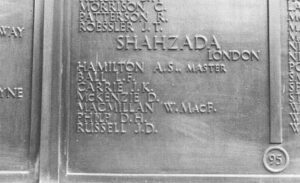
David Henry Owen Curtis, Lance Corporal, 3908839, South Wales Borderers. David was born at Newcastle Emlyn, the son of Frederick William and Sarah Ann Curtis. He was the husband of Margaret Mary Curtis, of Waterside, Londonderry, and served with the 2nd Battalion, South Wales Borderers. The battalion had been in Norway when the Germans invaded in 1940, and the survivors had been evacuated by the Royal Navy. It remained on home service until becoming the only Welsh unit to land in Normandy on D-Day, 6 June 1944. David didn’t see D-Day, but died on active service on 17 February 1943, aged 26. He is buried at Ardmore Roman Catholic Cemetery, Ireland. David is not commemorated locally.
Geoffrey Leon Dane, Corporal, 4973512, Sherwood Foresters (Nott’s and Derby Regiment). Geoffrey was the son of Mrs. A. M. Dane, of Newcastle Emlyn, and served with the 1st Battalion, Sherwood Foresters. In June 1940 the 1st Battalion was moved from Palestine to reinforce the Garrison of Cyprus, where they suffered their first war casualties in an air-raid. Early in 1942 the Battalion was moved to Egypt, converted to a motorised role and joined the Desert Army. Unfortunately after a sharp engagement in the Knightsbridge Box, the Battalion was ordered to surrender when the Garrison in Tobruk capitulated on 21 June 1942. Geoffrey was killed in action on 6 June 1942. He was 26 years old, and is buried at Knightsbridge War Cemetery, Acroma, Libya.
Frederick Evans, Private, 25137, New Zealand Infantry. Frederick was born at Aberarad in on 15 October 1899, the son of William and Rosetta Ann Evans, of Fronsilltyn, Brongwyn. Frederick had enlisted into the Royal Navy during the Great War, and continued to serve after the Armistice. By 1920, Frederick was serving aboard HMS Chatham, a Town Class Destroyer, which that year was lent to the Royal New Zealand Navy. He served aboard her for three years under New Zealand Command, before transferring into the Royal New Zealand Navy, and was living there at the outbreak of World War Two. Frederick enlisted at Auckland into the 18th Battalion, New Zealand Infantry, which was attached to the 2nd New Zealand Expeditionary Force, under the command of Bernard Freyburg, V.C. The NZEF departed for Egypt in 1940, and after training there, moved to Greece in April 1941, where it helped to defend Greece against a joint Italian-German offensive. After the surrender of Greece, most of the NZEF moved to Crete, where it helped in the attempt to defend the Island after the German airborne invasion of 20 May 1941. Frederick was one of the lucky ones who managed to get off Crete, and was evacuated to North Africa, seeing further service at the Battles of El Alamein. By 1943, he was feeling the effects of the war, and returned to New Zealand, dying there on 15 April 1944, aged 44. Frederick is buried at Auckland (Waikumete) Cemetery, New Zealand.

Herbert Prestyl Evans, Flying Officer (Pilot), Royal Air Force. Herbert was born in 1915, the son of Canon Gruffydd Evans and Mary Evans (nee Roberts), of Newcastle Emlyn. He was educated at Llandovery College before attending Reading University, where he graduated BA. Herbert then became a schoolteacher. In the summer of 1939 Herbert married Ivy Phyllis Joyce Rhodes, of Bury St. Edmunds. He enlisted into the Royal Air Force and trained as a pilot before being posted to 115 Squadron, Royal Air Force, a Bomber Command unit which was equipped with the Vickers Wellington, and based at RAF Marham. On the night of 15 May 1940, Herbert took off from Marham flying a Vickers Wellington IA, Serial P9229 KO-S, on a raid on Duisberg, the first RAF raid on an industrial city in the heart of Germany. Herbert was killed, alongside his crewmates, when their Wellington was brought down over France and crashed into high ground at Plainville close to Bernay during the early hours of 16 May 1940. Herbert was buried alongside his crew in Bernay (Ste. Croix) Communal Cemetery, France.

Eric William Worswick Feldon, Flying Officer (Pilot), 142204, Royal Air Force Volunteer Reserve. Eric was the son of Reginald George Allcorn Feldon and Maud Feldon, and the husband of Mary Feldon, of Llanishen, Glamorgan. Eric served with 268 Squadron, Royal Air Force. The squadron was equipped with the North American Mustang Mk IA by 1944. It flew important missions against important ground targets, such as radar installations. The Squadron was also tasked with reconnaissance against the German V1 flying bombs sites then starting to appear in France and was responsible for obtaining some of the first, clear, low level photography of V1 launching sites in France. Eric was killed whilst flying one of these missions over occupied France on 7 March 1944. He was just 20 years old, and is buried at Bayeux War Cemetery, France.

Eric Sydney Hall, Private, 4209748, Queens Own Royal West Kent Regiment. Eric was born at Newcastle Emlyn, the son of Harold Goodyear Hall and Alice Laura Hall. The family later moved to Gwaelod-Y-Garth, Taff’s Well, Glamorgan. Eric served with the 4th Battalion, Queen’s Own Royal West Kent Regiment. The battalion fought in the Far East, during the campaign in Burma against the Japanese. Eric was killed in India on 26 March 1944, aged 20, and is buried at Chittagong War Cemetery, Bangladesh. Eric is not commemorated locally.
Frederick Clifford Isaac, Second Engineer Officer, Merchant Navy. Frederick served in the Merchant Navy, as Second Officer aboard the S.S. Rio Azul, a London registered cargo steamer. On 29 June 1941, she was on route from Pepel for Middlesbrough carrying a cargo of 6,700 tons of Iron ore, when she was torpedoed by the German submarine U-123 and sunk. Frederick drowned in the sinking of the ship that day. He was 41 years old, and is remembered on the Tower Hill Memorial, London. Frederick is also commemorated on the Bethel Chapel Memorial at NCE.

Eric Spencer Jones, Lieutenant, 264500, East Lancashire Regiment. Eric was the son of Evan Spencer-Jones and Margaret L. Spencer-Jones (nee Thornley), of Newcastle Emlyn. After leaving Christ College, he went to Keble College, Oxford, but as soon as he was old enough he enlisted into the Officer Training Corps, before being commissioned as Second Lieutenant into the Royal Armoured Corps on 30 January 1943. He was then posted to the 8th Battalion, East Lancashire Regiment, which formed the nucleus of the 144th Regiment, Royal Armoured Corps. The regiment originally trained with Churchill tanks, but after being forced to hand their tanks over to a Canadian unit, re-equipped with Shermans and a number of Crusaders, before beginning to land in Normandy from 8 June 1944. Eric landed at Normandy with the unit on D-Day plus 3, 9 June, and fought through the epic battles of Normandy, where the regiment came up against the Waffen SS Panzer Unit ‘Schwere SS-Panzer-Abteilung 101’, commanded by Michael Wittman. The famous Panzer Commander was killed during this engagement at Hill 122. Eric survived Normandy, and fought through France into Belgium and Holland with the Division. In December 1944 the Germans launched a desperate attack in the Ardennes, known as the Battle of the Bulge, and British Units were rushed to plug the gaps in the lines of the US Forces in the area. Eric was killed in action during the Battle of the Bulge, on 13 January 1945, aged just 22, and is buried at Hotton War Cemetery, Belgium.
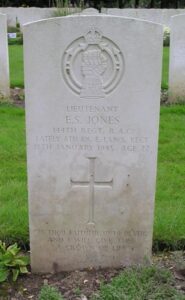
Haydn John Jones, Stoker 1st Class, P/KX 95866, Royal Navy. Haydn was the son of Evan and Beatrice Rebecca Jones. He served in the Royal Navy, as a pre-war regular, aboard the mighty Battleship H.M.S. Hood. She had been built and launched just before the end of the Great War and during the inter-war years was modified and modernised, with improvements in her armour the main priority. In June 1939, she joined the Home Fleet’s Battle Cruiser Squadron at Scapa Flow and when war broke out later that year, she was employed principally in patrolling the vicinity of Iceland and the Faroes to protect convoys and intercept German raiders attempting to break out into the Atlantic. When the German battleship Bismarck and the Prinz Eugen sailed in May 1941, Hood was sent out in pursuit, together with the newly-commissioned Prince of Wales, to intercept the German ships before they could break into the Atlantic and attack Allied convoys. The ships caught up with Bismarck and her consort, the heavy cruiser Prinz Eugen, in the Denmark Strait between Greenland and Iceland on 24 May 1941, and engaged them in battle. Unluckily for the ‘Mighty Hood’, a salvo of shells from the Bismarck broke through her deck, and the ship exploded, sinking in two minutes. Of the 1,418 men aboard her, only three escaped alive. Haydn was one of the unlucky ones. He was 26 years old, and is remembered on the Portsmouth Naval Memorial.
Ronald James Jones, Able Seaman, D/JX 188034, Royal Navy. Ronald was the son of John and Eleanor Jones, of Newcastle Emlyn. Ronald was a pre-war regular in the Royal Navy, and served aboard H.M.S. Edinburgh. HMS Edinburgh served as escort during World War 2 for the North Atlantic Convoys. On escort duty during the Russian Convoys she was torpedoed by U-Boat U456 while escorting Convoy QP11 on May 2 1942, she was carrying a cargo of £45million in gold bullion, which was a part payment by Stalin for War Materials. After a desperate attempt by her crew to save her, and a gallant battle against further German aerial and sea-borne attacks, the Edinburgh was scuttled and sank. Ronald was killed in action aboard her on 2 May 1942, and is remembered on the Plymouth Naval Memorial, Devon. Ronald is not commemorated locally.

Thomas Benjamin Morris, Sergeant, 1325871, Royal Air Force Volunteer Reserve. Thomas was the son of Hugh and Mary Ann Morris, and the husband of Rachel Bowen Morris, of Morriston. He served with 149 Squadron, RAFVR, which was a Night Bomber unit equipped with the Vickers Wellington. The squadron played a prominent part in the early offensive against Germany, Italy and enemy-occupied territory and, after having re-equipped with Stirling’s, took part in the first 1,000-bomber raids. In 1943 it made a significant contribution to the Battle of the Ruhr, and also took part in the Battle of Hamburg and the famous raid against the German V-weapons experimental station at Peenemunde. On 29 May 1943 Thomas took off in his Short Stirling, from their base at R.A.F. Lakenheath in Suffolk. The Squadron were forming part of a massive force of 719 aircraft, bound for Wuppertal in the Ruhr Valley. The Stirling was brought down by German Night Fighters on the return journey on the morning of 30 May, and Thomas was killed in the resulting crash. He was 29 years old, and is remembered on the Runnymede Memorial.
Tommy Douglas Morris, Gunner, 4209141, Royal Artillery. Tommy was the son of John and Elizabeth Morris, of Adpar, and served with the 146 (The Pembroke Yeomanry) Field Regiment, Royal Artillery. The 146th Field Regiment was raised in Ceredigion, and joined the Eighth Army in the Middle East in time to take part in the Battle of El Alamein. Afterwards it became part of the 7th Armoured Division, taking part in the advance to Tripoli, and played a part in defeating Rommel’s counter-attack at Medenine. Following the fall of Tunis in May 1943 the regiment landed at Salerno, and took part in the crossing of the Volturno. Tommy was killed in action in Italy just after the crossing, on 9 October 1943 aged 22, and is buried in Naples War Cemetery, Italy. Tommy had been named after an uncle who was killed in WW1, Tom Davies, of the 6th Welsh.
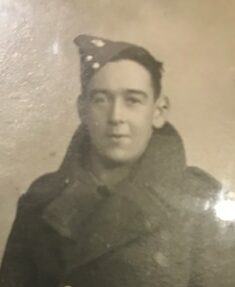
Wilfred Saunders, Lieutenant, 262155, Royal Welch Fusiliers. Wilfred was the son of Thomas and Mary Saunders, and the husband of Jean Saunders, of Newcastle Emlyn. Wilfred served with the 4th Battalion, Royal Welch Fusiliers, who landed in Normandy after D-Day, on 25 June 1944 as part of 158 Brigade, 53rd (Welsh) Division. The Division took part in the break-out from the Normandy beach-head and in the ensuing fighting in the Bocage. On 14 July, 158 Brigade became temporarily attached to the 15th (Scottish) Division in order to take part in the capture of the Ferme de Mondeville, south of Evrecy. The attack was launched on the night of 16/17 July, and the 4th RWF were ordered to clear Evrecy. Heavy casualties were suffered during the attack, especially by the 4th RWF, which lost a third of the men in the attacking companies. Wilfred was killed in action at Evrecy during this fighting, on 17 July 1944, aged 29. He is buried at Banneville-La-Campagne War Cemetery, France.

David Dan Haydn Thomas, Third Engineer Officer, Merchant Navy. David was the son of D. J. Thomas, and of Elizabeth J. Thomas, of Adpar, and served in the Merchant Navy, as an Engineer aboard the SS Parracombe. The Admiralty sent plans to the C-in-C Med, concerning the intended sailing of the SS Parracombe early in April, 1941. She was carrying about 12 Hurricanes, a number of Harvey projectors with their ammunition and other stores direct to Malta from Gibraltar, and was disguised as Vichy French, unescorted & manned by picked crew, with orders to be scuttled if captured. The Parracombe was attacked by Italian Torpedo Bombers and sunk on 2 May 1941, and David was killed. He was just 20 years old, and is remembered on the Tower Hill Memorial, London.

David Glanmor Williams, Pilot Officer, 160521, Royal Air Force Volunteer Reserve. David was the son of Mr. and Mrs. Evan Williams, of Newcastle Emlyn, and the husband of Gwen Williams, of Pontyberem. David served with 14 Squadron, RAF. By the start of World War II No. 14 squadron was flying Wellesley bombers. With the expected advance of Axis forces through Africa, the Squadron began bombing targets in Eritrea in June 1940 before re-equipping with Blenheim’s in September 1940 and a flight of Gladiators by the end of the year. These were used until August 1942 when Marauders were taken on strength and used in the anti-shipping role. The Squadron moved to Algeria in March 1943 for anti-submarine duties. David was taking part in a routine flight when his aeroplane was lost on 19 October 1943. He was 23 years old, and is remembered on the Malta Memorial. David is not commemorated locally.
